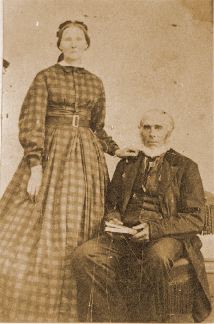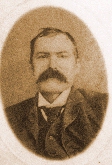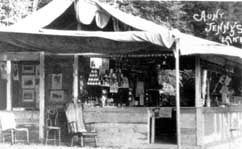| Background: |
Until about 1871, Germany was made up of sovereign states which were constantly at war. All of the men were subject to draft. Beyond this, they were heavily taxed and were forced to follow the religion of the ruler. Inheritance laws were unfair; property was to be equally divided among all the sons which resulted in the fragmentation of farms into lots too small to support a family. Daughters were left with little to contribute to their support. The land bordering the Rhine River was known as the Palatinate, and the people known as Palatines. In 1709, thousands of these Palatines left their homes and went down the Rhine River to Rotterdam. They petitioned the English Crown for sanctuary. The English granted this petition.
|
|
Before 1680 (dates unknown) |
Claus Rickert - b ---? d. 1674 Hailey, Hessen, Germany
|
| 1680 - 1700 |
Johann Conrad Rickert - baptized Feb. 2, 1680
Governor Hunter of NY was visiting England around that time and suggested that the Palatines be transported toNY where they could be put to work harvesting pine tree pitch, which was needed by the English Navy. Toward the end of 1710, ten ships were loaded with about 3,000 of these people and set sail from Plymouth. It was a difficult voyage, with many storms. The people were overcrowded and lacked food and water. Many died en route, especially children. Many of the passengers ate rats to stay alive. They landed at Governor's Island in NY Harbor where they remained for some time in Quarantine. Conrad Rickert and his family moved to an area called Livingston Manor. They were shown on the sustinance list of 1711 as having 2 adults and 3 children and again in 1712 as having 3 adults and 2 children. The reason is that children over the age of 10 (a working age, in those days) were considered adults. The English project failed and was given up in the fall of 1712. Some of the Palatines (including Conrad and his family) moved to the Schoharie Valley of New York. He later donated land in Schoharie for a Dutch Reformed Church and cemetery. Conrad and his wife had a son named Marcus who was born in Schoharie in 1713. In 1714 another census list showed Conrad and his wife, Sara Catharine and 4 children living in Schmidtsdorff, a dorf of Schoharie. Conrad was later involved in the Burnettsville Patent of Jan. 17, 1722, granting 100 acres of Indian land to 39 families. Because of trouble with the Indians, the Rickerts returned to Schoharie. |
| 1700-1730 |
Johann Conrad Rickert - bapt. Feb. 28, 1703, Germany
|
| 1730-1750 |
Johannes Rickert - bapt. May 19, 1728 at Schoharie, NY
|
| 1750-1780 |
Johan Georg Rickert b. 1753 Schoharie NY died Putnam NY - interred private cemetery
|
| 1780-1810 |
Heinrich (Henry) Rickert b. Oct. 18, 1784 died Jan. 5, 1854 age 69
|
| 1810-1840 |
Rev. James Rickert b. Aug. 2, 1808 died Sept. 27, 1877
 James Rickert had remarkable ability. His education was acquired by his own unaided efforts. In his younger days, he was seen after his days work was done, night after night, studying by the light of a pine knot. James Rickert had remarkable ability. His education was acquired by his own unaided efforts. In his younger days, he was seen after his days work was done, night after night, studying by the light of a pine knot.His first experience as a school teacher was in Whipple Hollow Vt. (on the back road between Rutland and Florence) where he taught 1 winter for $8 per month. He returned to Putnam NY where he taught for several years. James studied for the ministry. He preached in the Free Will Baptist Church in Putnam. He was ordained and preached in 1866 in the Wesleyan Methodist Church in Forest Dale Vt. In 1868 he was preaching inthe Wesleyan Methodist Church in Stony Creek NY. The house that James lived in in Putnam NY after his marriage he bought from David Blair (his mother's brother) and moved it to Rickert's Hill, placing it in front of where his father's log cabin stood. In 1905 Jame's son, Van Myron, still lived in that house but by 1968 the roof and floor were slowly caving in. |
| 1840-1870 |
Philo Kilborn Rickert b. Sept. 28, 1843 Putnam NY d. Nov. 1, 1898 Laconia NH age 54 married Jennie L. Dutton (b. Feb. 18, 1856 Salisbury Vt. d. June 7, 1934 Lake Dunmore Vt.) Dec. 30, 1871 children: 
 Harley died in Laconia in 1895. Philo died in 1898, and the youngest son Paul became very ill. Jennie moved herself and 2 boys back to Forestdale where she joined her sisters cooking for the men in a sawmill at Lake Dunmore.
Harley died in Laconia in 1895. Philo died in 1898, and the youngest son Paul became very ill. Jennie moved herself and 2 boys back to Forestdale where she joined her sisters cooking for the men in a sawmill at Lake Dunmore. Later, she built a tea room near the scenic waterfalls called the Lana Cascades and served summer visitors. She ran the teahouse until her death in 1934 and was well known and well loved around Lake Dunmore.
|